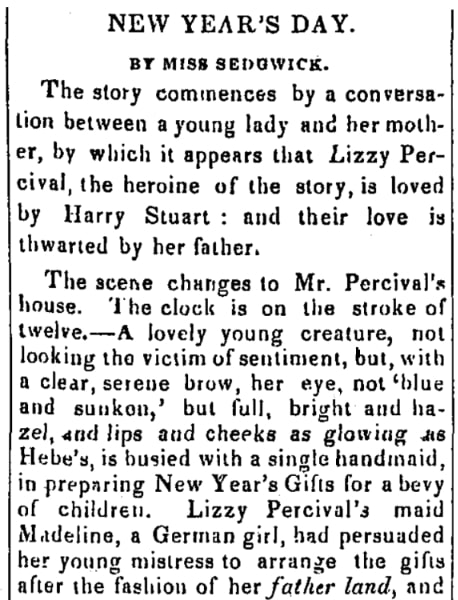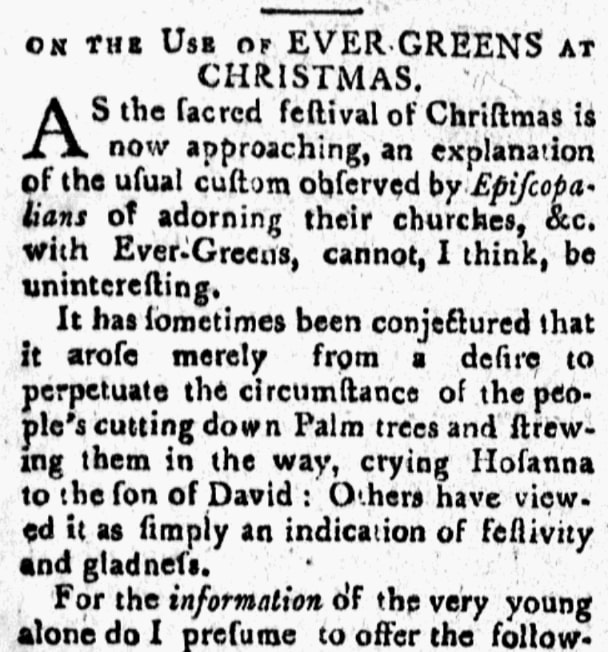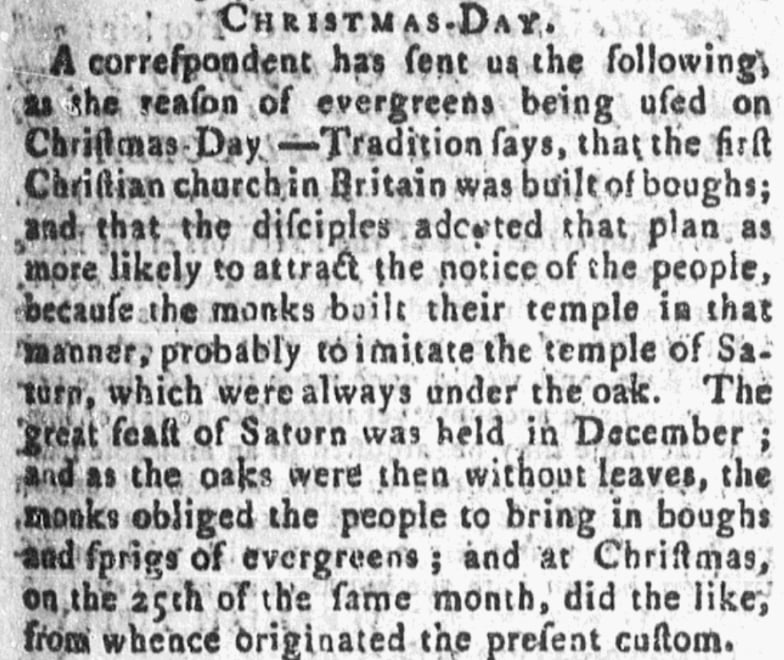Introduction: In this second article, Katie Rebecca Merkley gives more history of celebrating Christmas with Christmas trees set up inside the home. Katie specializes in U.S. research for family history, enjoys writing and researching, and is developing curricula for teaching children genealogy.
The Pawtucket Chronicle published a story in 1835, only identifying the author as “Miss Sedgwick.” A Christmas tree appeared in the story and became a popular Christmas decoration.

The story is set “during the last hour of the last night of 1834.” It opens with Mary Moore lamenting Lizzy Percival’s situation to her mother.
According to Mary, Lizzy was raised by a stepmother and takes care of younger siblings, and her father disapproved of her beau, Harry Stuart. Mary’s mother is more optimistic about the situation.
The scene changes to Lizzy Percival and her German maid, Madeliene. Lizzy had gifts for her younger siblings, and Madeleine persuaded Lizzy to present them in the manner of her fatherland. So, the girls obtained a Christmas tree, set it up on a table in the library, and put toys and treats on the boughs. The toys included books, chessmen, puzzles, dolls, birds, beasts, boxes, a regiment of toy soldiers, and Noah’s ark. Treats included cherries, plums, strawberries, and peaches “as tempting and at least as sweet as the fruits of paradise.”
As they were finishing up, Harry Stuart gave Lizzy a ring and a note, then Lizzy went to bed. The next morning, gifts were distributed. Lizzy’s father asked her what he should give her, and she replied that she wanted his leave to wear the ring Harry Stuart had given her. After opening her present for him, which consisted of homemade slippers and stockings, her father gave her leave to wear the ring for that day.
Lizzy and Madeleine then went to visit a widow, Mrs. Carey, and her children, delivering presents, which were old toys from the Percival children. During the visit, Mrs. Carey reluctantly informed Lizzy that she was in danger of being evicted unless she could pay double the rent. Lizzy inquired who the landlord was and went to the address to plead on Mrs. Carey’s behalf. The landlord agreed and then inquired who Lizzy and her family were.
Lizzy had to hurry home to entertain New Year’s visitors while her father went making New Year’s visits. After Mr. Percival had returned home, he had a visitor. It turns out, Mrs. Carry’s landlord was Harry Stuart’s father and Mr. Percival’s former friend!
They had had a falling out years ago and reignited their friendship that day because of Lizzy’s influence. Due to that day’s events, Mr. Percival approved of Harry for Lizzy.
The Christmas tree was only mentioned once throughout the story, and the scene with the Christmas tree had little bearing on the plot. Yet this story, published in multiple newspapers in 1835, was influential in making Christmas trees popular in America.
For example, this story was published in Boston on October 3; Salem, Massachusetts, on October 13; Portsmouth, New Hampshire on October 20; St. Albans, Vermont, on October 27; Bennington, Vermont, on November 17; Albany, New York, on December 1; and in Saratoga Springs, New York, on December 15, just to name a few.
Evergreen Wreaths & Garlands
What about your ancestors who celebrated Christmas in America before the 1830s, in England before the 1840s, or in Germany before the 1770s? They didn’t decorate with Christmas trees. Instead, they made wreaths and garlands out of evergreen branches of holly, ivy, pine, or whatever was available locally. They also hung mistletoe.*

A search in GenealogyBank’s Historical Newspaper Archives for “Christmas tree” had very few results before 1835. One of the few I found was this 1831 ad mentioning Christmas trees.

There are earlier newspaper articles mentioning Christmas evergreens. You might think they are referring to Christmas trees, but they are more likely referring to wreaths and garlands made of evergreens.
The Columbian Centinel published an article in 1791 about an evergreens Christmas tradition, referring to early Christians and declaring evergreens as “a symbol of him ‘whose leaf never withers’ and an evidence of their belief in his unchanging glory and immortality.”

Another newspaper that same year said the Christmas tradition of evergreens harkens back to the first Christian church in Europe. They wanted to use oak, but since oak trees are without leaves in December, they used evergreens instead.

This article reports:
Christmas Day.
A correspondent has sent us the following, as the reason of evergreens being used on Christmas Day – Tradition says, that the first Christian church in Britain was built of boughs; and that the disciples adopted that plan as more likely to attract the notice of the people, because the monks built their temple in that manner, probably to imitate the temple of Saturn, which were always under the oak. The great feast of Saturn was held in December; and as the oaks were then without leaves, the monks obliged the people the bring in boughs and sprigs of evergreens; and at Christmas, on the 25th of the same month, did the like, from whence originated the present custom.
The Christmas tree tradition has not entirely replaced the other uses of evergreens. That tradition has evolved with the Industrial Revolution. Many people hang wreaths on their doors or windows at Christmastime. Many buy wreaths premade, while crafters buy supplies to make their own wreaths. Garlands still adorn many houses and buildings at Christmastime. Whatever the decorations are, however obtained, the reason for putting them up is the same now as it was for our ancestors: to make a place look festive.
* Anthony & Peter Miall, The Victorian Christmas Book (Secaucus, NJ: Chartwell Books Inc., 1990), p. 51.
Explore over 330 years of newspapers and historical records in GenealogyBank. Discover your family story! Start a 7-Day Free Trial
Note on the header image: “Happy Christmas” by Johansen Viggo, 1891. Credit: Wikimedia Commons.
Related Article:
